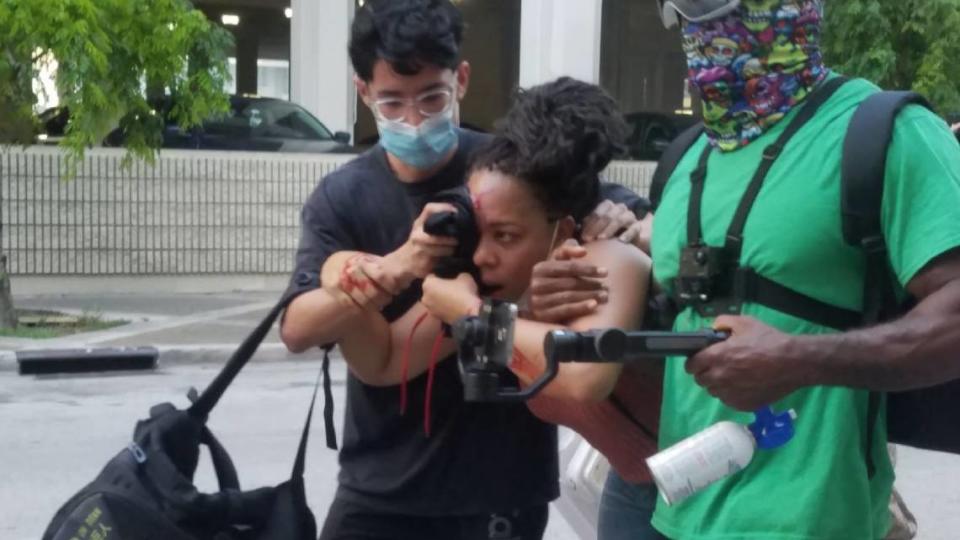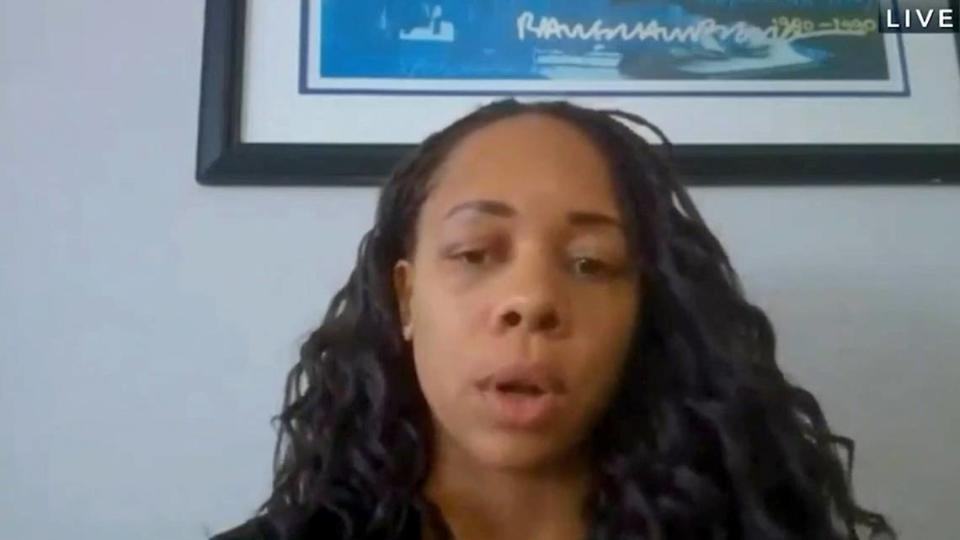A cop shot a peaceful protester in the face with a rubber bullet. The city cleared him.
Fort Lauderdale Police Department Detective Eliezer Ramos did nothing wrong when he shot a peaceful protester in the face with a rubber bullet at a Black Lives Matters protest on May 31, the department announced at a news conference Thursday.
An internal affairs investigation determined it was not Ramos’ “intention” to strike the protester, LaToya Ratlieff, according to Interim Police Chief Patrick Lynn.
“To Ms. Ratlieff, we have worked together all the facts of this case for a clear understanding of what occurred,” Lynn said. “On behalf of the men and women of the Fort Lauderdale Police Department, I want to express my sincerest apologies for the experience you have had with our police department.”
Ratlieff was shot as she was choking on tear gas and stumbling away from a conflict that police provoked, a Miami Herald investigation found. Ramos’ rubber bullet left Ratlieff with a broken eye socket. She needed 20 stitches to close the two-inch gash the projectile ripped into her forehead. Since then, her recovery has been long and lonely: She still gets debilitating migraines, has difficulty remembering words and sees strange flashes in her injured right eye.
The shot could have killed her, according to the department’s weapons policy. It states that officers using “foam baton” rounds, like the one fired by Ramos, should aim for the head and neck “only if deadly force becomes necessary.”
Ramos said he was aiming for a protester who threw a chemical munitions canister back at officers. Ramos said he mistakenly hit Ratlieff. Video shows that the other protester was standing behind and to the right of Ratlieff. In his statement to internal affairs, which was released Thursday, Ramos acknowledged that “it looked like [the protester] was trying to use people as shields.” Still, he had a clear and “safe” shot when he fired, the detective said.
Investigators ultimately exonerated Ramos on two allegations: careless or reckless use of a firearm and unnecessary force.

In response to the department’s findings, attorneys for Ratlieff held a press conference outside Fort Lauderdale City Hall Thursday afternoon.
Michael Davis, one of her lawyers, said Ratlieff is prepared to file a federal civil rights lawsuit against the city — unless the police department enacts reforms.
“This investigation has always been about trying to justify what happened and trying to demonize LaToya Ratlieff and other peaceful demonstrators who were exercising their First Amendment right,” Davis said. “We knew what the result was going to be. But I think we still had hope that the right thing will be done. Ms. Ratlieff is very disappointed, but not surprised.”
While internal affairs investigators cleared Ramos, they did find that two other officers had violated a departmental policy against using “vulgar, obscene or offensive language” while on duty. The officers were caught on a body camera laughing and cursing after shooting rubber bullets at protesters. Both men have been suspended for one day, according to records released by the department Thursday.
A 90-page internal investigations report into Ramos’ case blames protesters for the violence, asserting that some people showed up “with the intent to engage law enforcement, in the hopes of eliciting a response and causing harm to persons and property.” The report, released Thursday, doesn’t mention that one officer, Steven Pohorence, was caught on video shoving a kneeling young woman in the head in view of dozens of people. Pohorence’s conduct set off an angry reaction from protesters, who tossed water bottles. Police responded with tear gas and rubber bullets.
Lynn, the interim chief, took no questions after the news conference. He recently replaced another interim chief, Karen Dietrich, who stepped down after expressing frustration with the job.
“I wish nothing but the best to whoever sits in this seat because it’s not an easy job,” Dietrich said in an interview with radio station WIOD. “It will suck the life out of you if you let it.”
‘A good guy’
The internal investigation into Ramos started off inauspiciously.
In August, the department’s initial lead investigator, Sgt. Jeffrey Newman, was reassigned after he told Ratlieff that he was “sure [the shooting] was an accident” during an official interview. He also said that Ramos was a “good guy,” according to the South Florida Sun Sentinel. Ratlieff’s attorney said she was harshly questioned about whether she threw anything at officers during the protest. (She did not, video footage shows.)
The final IA report shows investigators consulted an independent use-of-force expert, who reviewed body camera footage and other evidence and concluded that Ramos had been aiming for another protester, not Ratlieff.
“The expert ... opined that although Ms. Ratlieff was unfortunately struck, the deployment of the less lethal weapon was not done so in a reckless manner. As the expert noted the event was chaotic,” the report states. “Detective Ramos deployed the weapon towards an individual who was throwing a dangerous object towards officers. ... Based on studies cited by the expert, due to the human reactionary gap, it takes time to observe, orientate, decide and act. Detective Ramos observed the threat and reacted to it.”
As Ramos fired, according to the report, “Ms. LaToya Ratlieff crossed directly within the deployed munitions path of travel.”
The independent expert, John J. Ryan, is an attorney who served for 20 years as a police officer in Rhode Island, according to his firm’s website.
I have it on video she wasnt even doing anything literally just trying to escape the gas pic.twitter.com/Gd3sasbhrb
— Ondine Duquette Stan Account (@TheCrownedB) June 3, 2020
Danny Suarez, a former member of Miami’s Civilian Investigative Panel, an oversight board for the city’s police department, said that internal investigations are often a “rubber stamp ... and their objective in many cases is to find ways to justify the officer’s actions ... [or] find a lie within the victim’s statement.”
Suarez pointed out that under state law officers are allowed to see the evidence against them, including videos, before they are questioned by IA investigators. That makes it possible for them to change or coordinate their stories to fit the evidence, he said.
“It’s easy to get away with this kind of reckless behavior thanks to the Law Enforcement Officers’ Bill of Rights,” according to Suarez. “No way in hell you should be shooting into a crowd.”
Ramos was not the only Fort Lauderdale officer whose conduct came under scrutiny after the protest.
Detective Zachary Baro and Officer Jamie Chatman were found to have celebrated after shooting at protesters with rubber bullets. Baro appeared to believe — incorrectly — that his body camera was turned off. The Herald obtained the footage through a public records request.
“Are you off?” Chatman asked Baro as they stood behind a line of SWAT officers.
“Yeah, I’m on stand-by,” Baro replied.
“Did you see me f**k up those motherf****rs,” Chatman crowed.
Nonetheless, Baro was exonerated on a charge of having his body camera improperly turned off, according to department records. Investigators determined that as a SWAT team leader Baro had wide discretion to keep his body camera on or off.
When IA asked Baro if he should have cursed at protesters, he responded: “If I knew I was being recorded, I would say probably not.”
A sudden spurt of violence
The May 31 George Floyd protest had remained relatively peaceful all day — until Pohorence shoved the young woman outside a downtown parking garage as many people returned to their cars.
Dozens of protesters saw the shove and several threw water bottles at a retreating Pohorence as another officer, Krystal Smith, who is African American like most in the crowd of protesters, berated him. Video of the incident went viral.
Pohorence was criminally charged with misdemeanor battery. He has pleaded not guilty.
The IA report does not mention Pohorence.
It does, however, reference an incident before the shove when protesters surrounded another officer’s car. The officer said protesters pounded their firsts on the vehicle and jumped on the trunk. The officer’s body camera was turned off. Protesters and Herald photojournalists in the area said they did not see a violent attack on the officer’s car, although the department produced photographs taken the next day showing footprints on her trunk.
Still, the officer said she believed her life was in “imminent danger.” She put out a distress call, to which Pohorence and dozens of other officers responded. The situation appeared to have calmed down until Pohorence’s shove, which ignited a conflict that would last for hours through downtown streets, videos show.
Other officers also said they were attacked while in their vehicles and feared for their lives. “F**k the police, you want to kill me get out the truck and I’ll show you who will get killed,” one officer said a protester shouted while trying to open his vehicle doors.

While Fort Lauderdale Police Chief Rick Maglione defended how his department handled the protest, the city removed him as chief in July, although he remained on the force. At the time, Mayor Dean Trantalis said Maglione’s law enforcement strategy “was not consistent with the goals of our community.” The city is currently looking for a new chief. Not until Thursday had it issued a formal apology to Ratlieff, which she has sought along with police reforms.
On Friday, Ratlieff will return for the first time to the downtown corner where she was shot last spring. Her appearance was announced earlier this week. Ratlieff plans to hold a news conference criticizing a bill moving through the Florida Legislature that would create new criminal penalties for protesters.
The bill is a top legislative priority of Republican Gov. Ron DeSantis. Supporters acknowledge it was filed in reaction to the racial justice protests that swept the nation in the summer of 2020 after Floyd’s death at the hands of Minneapolis police.
Miami Herald investigative reporter Sarah Blaskey contributed to this report.

